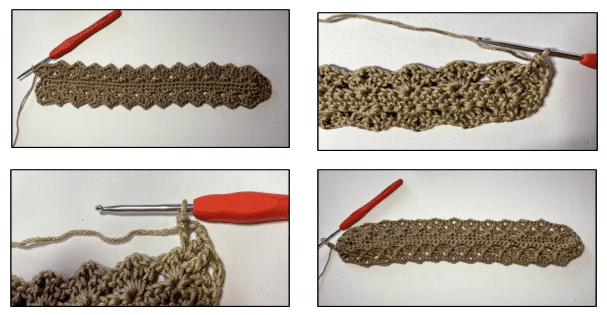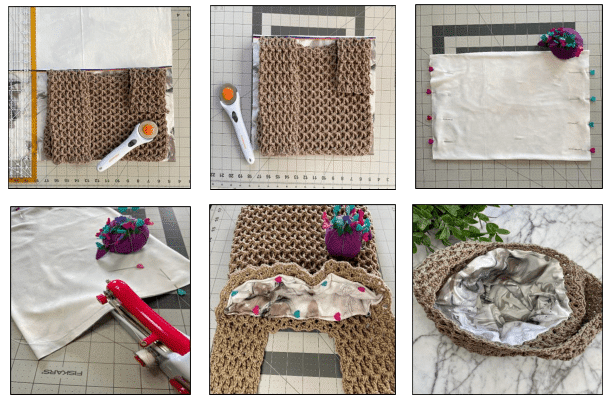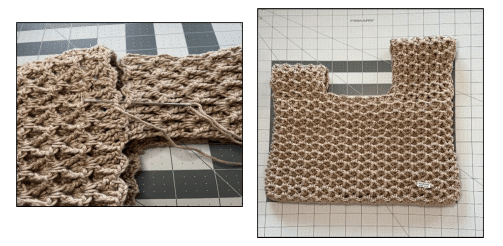To close the bag, just tie a knot with the handles; the fashionable Japanese knot bags served as inspiration for this unusual fastening.
Which yarn is best for making this knot bag?
A crochet pattern?
For the Coco knot crochet pattern, you can use any worstedweight cotton yarn that you like; however, I find that mercerized cotton works better than regular cotton yarn because it will give you a better stitch definition and durability in addition to being stronger, smoother, and shiny.
Working with it is further simplified when you use the smaller hook size that was specifically selected for this design.
I used Lion Brand 24/7 mercerized cotton, a robust cotton yarn with a wide range of color possibilities, which is one of my favorite cotton yarns.
Completed measurements
The bag is large enough to fit your daily necessities, measuring 9 inches in height and 11 inches in breadth. Simply use the stitch count for the repetition that I included in the design to get the desired size, and don’t forget to modify the handles’ length and breadth accordingly!
The crochet pattern for the Coco Knot bag’s lining If you want the bag to be more utilitarian and sturdy, I strongly advise lining it.
The bag’s lining will also give it a lovely finish and keep it clean. The extra work is worthwhile because the method is simple and only takes rudimentary handsewing abilities. And don’t worry, I’ve included a simple, step-by-step technique in the directions for full photo lining.
Don’t forget to add a handmade faux leather tag to your bag.
How should you maintain your Coco Knot Bag?
You may wash and dry your crocheted bag as much as needed because it is made entirely of cotton yarn.
Ensure that you place it in a washing bag as opposed to running it through a standard wash cycle. And to dry it, I like to let my crocheted items air dry first. After they are completely dry, I give them a little shake in the dryer to fluff the yarn and restore their natural shape.
To be sure, be sure to read the washing directions on the yarn’s skein label if you’re not using 100% cotton, but you should be able to
A brief summary
- The pattern is straightforward, thorough, tested, and comprehensive.
- Written in phrases that are Standard American.
- The beginner’s skill level is advanced.
- Worsted weight cotton yarn was used to make it.
- Hook for crochet: D/3mm.
- Size (to the handles): W=12′′/H= 9′′.
The pattern comes with comprehensive step-by-step written directions, a full picture tutorial in excellent quality, and a step-by-step photo tutorial just for lining.
Finished Approximate Dimensions:
H= 9“ (to the base to the handles)/ W= 12”
What you will need
- Lion Brand 24/7 cotton: worsted weight yarn, 100% mercerized cotton
Color: Taupe - Yardage: 450 yards
- Crochet hook: 3 mm (to keep the tension tight). I used a hook from this hook set
- Gauge: 4” square/ 18 rows and 19 SC
- Fabric for lining: 14”/ 20” rectangle
- Metal Tag: I used Metal Label
- Stitch markers
- Tapestry needle
Abbreviations
CH: Chain, ST: Stitch, SL ST: Slip stitch, SC: Single crochet, DC: Double crochet FPDC: Front post double crochet, YO: Yarn over, Rnd: Round, Rep: Repeat RS: Right side, WS: Wrong side.
Front post double crochet: YO, insert your hook from front to back to front around the post of the next ST, YO, pull up a loop, YO, pull through 2 loops on your hook, YO, pull through remaining two loops on your hook.
Note: Mercerized cotton is the best yarn choice for this pattern. Various yarns, even though worsted may change the tension, the stitch definition and the measurement of this pattern. If you choose another yarn, use a hook size smaller than the hook size suggested by your yarn and do gauge swatch.
Step 1- Crochet the body
The bag is crocheted in “rounds” using a Waffle V Stitch, but instead of working continuously in circle, you work back and forth from the starting stitch. You must turn your work at the end of each round, working one round on the right side of the work (RS) and the following round on the wrong side of the work (WS). Use a stitch marker to identify the
start of rounds Chain 53 (or a multiple of 4 +1) to make a foundation chain (keep your tension a little loose here)
- Rnd 1: 2 SC in the 2nd CH from the hook, SC in next 50 ST, 3 SC in the last CH. Continue crocheting along the back unused loops of the foundation chain, SC in next 50 ST (crochet over the tail to hide it), SC in the last CH already holding the 2 SC, join with a SL ST into the 1 st SC, CH3.
- Rnd 2: (RS) (2DC, CH2, 2DC) in next SC, skip next 3 ST, rep * to* around, finish with (2DC, CH2, 2DC) in next ST, join with a SL ST into the top of CH3, CH3. (27) clusters, turn.
- Rnd 3: (WS) * Skip next DC, FPDC in next DC, (DC, CH2, DC) in next CH2 space, FPDC in next DC, skip last DC,* rep * to* around, finish with a SL ST into the top of the CH3, CH3, turn.
- Rnd 4- 26: ( about 9” ) rep Rnd 3 making sure you turn your work at the end of each round.
Finish Rnd 26 with a SL ST into the top of the CH3, CH3,turn, proceed to crocheting the handles.
Additional resources:

If needed, use the YouTube video in the link below, to get an idea on how the Waffle V stitch is made; you still need to follow the stitch count for the pattern.
Step 2- Crochet the handles
The handles are crocheted in rows, using the same stitch. Feel free to customize the length and width of the handles to your linking.
1st handle: about 6 ½” in length.
- Row 1: (WS) * Skip next DC, FPDC in next DC, (DC, CH2, DC) in next CH2 space, FPDC in next DC, skip last DC,* rep to across x 5 times, finish with a DC into last DC of the same cluster (use a stitch marker to identify this DC), CH3, turn.
- Row 2: (RS) * Skip next DC, FPDC in next DC, (DC, CH2, DC) in next CH2 space, FPDC in next DC, skip last DC,* rep to across x 5 times, finish with a DC into the top of CH3, CH3, turn.
- Row 3 – 16: rep Row 2 turning your work at the of each row. Finish last row with a DC into the top of CH3, fasten off and leave a long tail for sewing.
2nd handle: about 9” in length.
Place a ST marker 4 clusters away from the 1st ST marker, in the last DC of the 4th (2DC, CH2, 2DC) cluster, as shown in the 1st picture.
- Row 1: (WS) Slip knot then SL ST into the 2nd marked ST, CH3, * Skip next DC, FPDC in next DC, (DC, CH2, DC) in the next CH2 space, FPDC in next DC, skip last DC, * rep * to* across x 5 times, finish with a DC into last DC of the same cluster, CH3, turn.
- Row 2: (RS) * Skip next DC, FPDC in next DC, (DC, CH2, DC) in the next CH2 space, FPDC in next DC, skip last DC, * rep to across x 5 times, finish with a DC into the top of CH3, CH3, turn
- Row 3-25: rep Row 2 turning your work at the end of each row, Finish last row with a DC into the top of CH3, fasten and leave a long tail for sewing.

Step 3- Lining the bag
Lining the bag is easy and doesn’t require major sewing skills (you can hand sew). You will make a pouch with the fabric, the same size as the crocheted bag then insert it inside your bag and stitch it up at the top. It’s easier to line the bag before sewing the handles.
- Iron the fabric you are planning to use.
- Lay your fabric out on a smooth surface, fold it in half.
- Place your bag on top of it. The bottom of the bag should be on top of the folded side of the fabric.
- Fold the handles (see pic).
- Trace around the bag leaving roughly 1/2-inch extra fabric along the sides and top of the bag.
- Cut out your fabric.
- Sew the lateral sides of the fabric leaving the top side only unsewed. You just made a pouch!
- Place the pouch inside of the bag. Keeping the right side of the fabric facing outward.
- Adjust the lining carefully, fold down the fabric roughly 1/2 inch at the top and clip or pin to the crochet bag.
- Use a needle and thread to stitch around the top of the bag, sewing the lining and crochet together.
- Optional: stitch up the bottom of the bag to the liner.
Additional resources:

How to line a crocheted bag.
Step 4- Finish the bag
Sew the handles:
- With the right side of the bag facing outward, fold the handle in half, then align it with last Rnd of the back panel.
- With a tapestry needle and the long tail, sew the handle to the last round of the body, grabbing the back loops only, one stitch at the time. Fasten off.
- Sew the 2nd handle the same way you did with the 1st handle.
- Pull the long handle trough the short handle to close the bag.

Congratulations!
You just finished the Coco Knot Bag. I hope you enjoyed making it and are pleased with the results!